Phu Quoc Island: Location, History, Weather & Time to Visit
Phu Quoc is an island located in the Gulf of Thailand and is the largest island in Vietnam. Phu Quoc Island together with neighboring smaller islands and Tho Chu Archipelago 55 nautical miles to the southwest form the island city of Phu Quoc in Kien Giang province. Phu Quoc City was established in early 2021 on the basis of the former Phu Quoc island district and is the first island city of Vietnam.
1. History of Phu Quoc Island in Vietnam:
From the 5th century BC, people began to appear in Phu Quoc, bearing the characteristics of the Oc Eo culture, with no sign of the Khmer here. In 1671, a Chinese named Mac Cuu (Moc Kinh Cuu), a native of Lei Chau, Guangdong province, brought his family, soldiers, and some scholars about 400 people on a boat to leave Fujian. After many days at sea, Mac Cuu's delegation landed on a wasteland in the Gulf of Thailand. After investigating and knowing that this land was under Chenla's influence, the delegation immediately found a way to Oudong to seek asylum, but at that time there was chaos within Chenla.
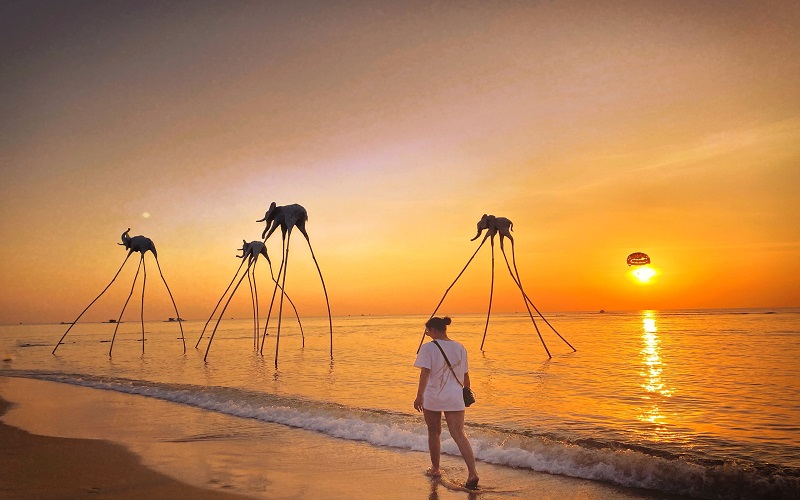
In 1680, Mac Cuu established hamlets scattered from Vung Thom, Trong Ke, Can Vot, Rach Gia, and Ca Mau. Ha Tien became an important trading port, the hamlet settled close to the sea, convenient for boats to come back and forth, or on high land along Giang Thanh, Cai Lon, Ganh Hao and Ong Doc rivers for cultivation. He established 7 casinos along the coast: Man Kham (or Mang Kham, Peam, Long Ky (Ream), Can Bot (Kampot), Huong Uc (Kampong Som), Sai Mat (Cheal Meas or Banteay Meas), Linh Quynh (Kiri Vong) and Phu Quoc (Koh Tral). The capital was located at Man Kham (ie Ha Tien), later changed to Can Khau (Can Khao or Can Cao). Rumors spread far, Chinese immigrants from all over the Gulf of Thailand asked to come here to settle down, gradually this land became a prosperous territory with a new name: Can Khau Quoc. Koh Tral Island also changed its name to Phu Quoc (rich land).

In 1708, Mac Cuu contacted Lord Nguyen Phuc Chu. In 1714, Mac Cuu asked to be a subordinate of Lord Nguyen and was ordained a general to rule the land of Can Khau. In 1724, Mac Cuu offered all the land and was appointed admiral to rule the territory of Can Khau, renamed Long Ho Dinh. Since 1729, Long Ho Dinh has been famous as the richest land in the Gulf of Thailand. In 1735, Mac Cuu died, his son was Mac Si Lan, later changed to Mac Thien Tu, was promoted to admiral, succeeded his father to rule Long Ho palace. The Mac family was elevated to the rank of king by Ninh Vuong Nguyen Phuc Chu. Long Ho palace changed its name to Ha Tien town. In 1739, Mac Thien Tu established four more districts: Long Xuyen (Ca Mau), Kien Giang (Rach Gia), Tran Giang (Can Tho) and Tran Di (Northern Bac Lieu).
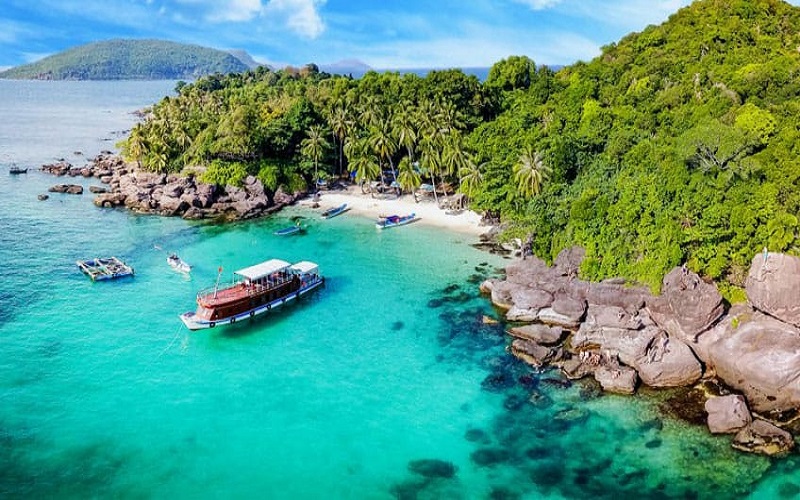
In 1755, Nac Nguyen asked Mac Thien Tu to offer Nguyen Lords the territories of Tam Bon (Tan An) and Loi Lap (Go Cong) to return to Nam Vang to rule. In 1758, Lord Nguyen made Nac Ton (Ang Ton II) king and was given additional territory of Tam Phong Long (Chau Doc and Sa Dec). Nac Ton personally gave Mac Thien Tu the territory of 5 provinces in the southeast of Chan Lap: Huong Uc (Kampong Som), Can Bot (Kampot), Chau Sum (Chan Sum could be Truc Sam, Chung Rump (Chan Sum) Chhuk now belongs to Kampot province, Chan Sum can also be Chan Sum (also known as Chan Chiem) located between Chau Doc and Giang Thanh, now is the region of Seven Mountains An Giang (where Chan Sum mountain is located), Sai Mat (Cheal Meas or Banteay Meas) and Linh Quynh (Kiri Vong).
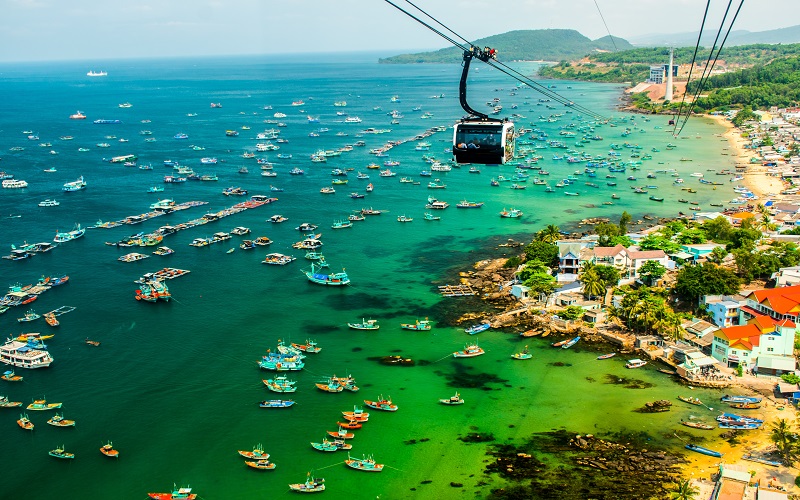
These five provinces are the coastal area (coast of the Gulf of Thailand) from Srae Ambel, Koh Kong province (ie Co Cong, bordering the Thai (Siamese) control area) to Mang Kham (Peam), the mainland opposite. In the northeast of Phu Quoc Island, Mac Thien Tu gave it all to King Nguyen Phuc Khoat. Martial King merged all new lands into Ha Tien town, assigned to Mac Thien Tu to rule.
In 1770, missionary Pierre Pigneau de Béhaine (Ba Da Loc) set foot on Phu Quoc and confirmed that residents here used Vietnamese to communicate, not Khmer. In 1822, British ambassador John Crawfurd on his journey to Siam and Cochin China (Vietnam) visited and discovered Phu Quoc island. On March 13, 1822, Crawfurd anchored the ship to board the largest island in the northwest. This island is inhabited by many people, they are hospitable and they are all Cochin Chinese.
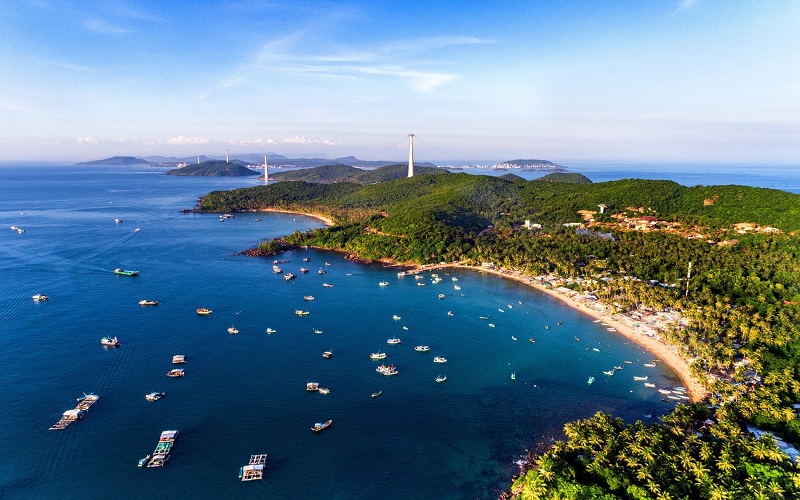
There are also Chinese people of Hainan origin on the island, so it is easy for Crawfurd's team to interpret. Crawfurd was told by the islanders that his caravan was the first Europeans they had seen to visit the island. He found that the people on the island were quite open, young and old, girls and boys did not feel bound by much. Crawfurd communicated with the island officials through his Chinese interpreter. In fact, they only used pens [to write kanji], without saying a word. This island is called Phu-kok [Phu Quoc] in Cochin China, Koh-dud in Thai, or "distant island". In Cambodian, this island is called Koh-trol, or shuttle island. The old map was called Quadrole.
During the French colonial period, the French placed Phu Quoc as an administrative agent, belonging to the inspection district of Kien Giang, then Rach Gia. On August 1, 1867, Phu Quoc belonged to Ha Tien county. On May 25, 1874, France established Phu Quoc county, including islands located in the area of 100°E - 102°E and 9°N - 11°30'N. At the same time, France also opened Duong Dong port for ships from other countries to trade.

During the Republic of Vietnam period, Phu Quoc was a coastal zone of the navy. In 1964, King Sihanouk of Cambodia declared that he accepted the colonial Brevie line as a maritime border, which meant giving up his claim to Phu Quoc, recognizing Phu Quoc under Vietnamese sovereignty. In 1969, the government of the Republic of Vietnam rejected the proposal to take the colonial Brevie line as the maritime border and proceed to expand the waters of Vietnam. The Khmer Rouge fully accepted the Brevie Line in their negotiations with the Vietnamese (although the Khmer Rouge launched a failed campaign to occupy the island in 1975).
2. Phu Quoc Climate and Weather Forecast:
Phu Quoc Island has a “Tropical monsoon” climate and weather. The highest temperature is about 30.5°C (86.9°F) and the lowest is 25.6°C (78.08°F), with an average yearly temperature of 28.2°C (82.81°F). Annual rainfall averages is about 1803.9 millimetres (71.02 inches).
Historical Monthly Average Climate & Weather Conditions in Phu Quoc.
| Months | High / Low (°C) | Rain Falls |
|
January |
28.4° / 25.6° |
8.7 days |
|
February |
28.4° / 25.8° |
5.9 days |
|
March |
29.2° / 27.0° |
11.5 days |
|
April |
29.9° / 28.0° |
17.5 days |
|
May |
30.5° / 28.8° |
22.0 days |
|
June |
29.8° / 28.2° |
21.1 days |
|
July |
29.1° / 27.6° |
20.8 days |
|
August |
29.0° / 27.5° |
21.2 days |
|
September |
28.9° / 27.3° |
20.5 days |
|
October |
28.9° / 27.2° |
22.6 days |
|
November |
29.1° / 26.8° |
20.1 days |
|
December |
28.6° / 25.9° |
9.1 days |
3. What is the Best Time to visit Phu Quoc Island Vietnam?
Being a tropical weather island near the equator and located in the Gulf of Thailand, Phu Quoc has quite different climatic features. The island has two seasons: the dry season and the rainy season.
- The dry season in Phu Quoc: From late October to mid-May is the dry season in Phu Quoc. At this time, when the rains have ceased and the waves are not too intense.
- The rainy season in Phu Quoc: May to early October is the rainy season in Phu Quoc. Located at the gateway to receive the monsoon West – Southwest, the air humidity is often remarkably high.
There’s constant rain with strong waves that hinder traffic from the mainland to the island. Sudden rains, which are not too long but heavy, can cause danger to people on the road.
In particular, it can be difficult to explore on rainy days because of slippery roads and limited visibility.
Typhoon period in Phu Quoc: From July to September is the typhoon season in Phu Quoc. At this time, the rain and storms are often unexpected. Rain and wind are intense, and the streets are likely to be flooded with limited traffic on the sea.
The best time to visit Phu Quoc Island is from October to March. During this period, it’s less rainy, and the waves are smooth, so it’s convenient for taking a ferry from Rach Gia to Phu Quoc.
Please note that it’s also a peak travel season in Phu Quoc. Therefore, if you travel at this time, you should book your flight tickets and hotels in advance.
4. How to get from Ho Chi Minh City to Phu Quoc Island?
This guide will give you some options on how to get from Ho Chi Minh to Phu Quoc Island. There are several ways that you can do this – by plane, by bus and ferry, as well as by private hire taxi.
The trip from Ho Chi Minh City to Phu Quoc will take around 10.5 hours by bus and ferry, 7.5 hours by private transfer (taxi) or if you are flying then the flight time is around 1 hour but you will need to allow further time for airport transfers and negotiating the airports.
The distance between Ho Chi Minh City and Phu Quoc is 378km in total and depending on your preferred method of transport the costs can range from USD19 to USD250 one-way.
- Flights from Ho Chi Minh to Phu Quoc:
There are currently three operators that have daily flights from Ho Chi Minh to Phu Quoc International Airport, namely Vietnam Airlines, JetStar Pacific and VietJet Air.
Vietnam Airlines have 3 daily flights from Ho Chi Minh's Tan Son Nhat International Airport (SGN) which is located about 6km (4 miles) north of the city centre. Flight prices are definitely leave much to be desired and start from USD100 one-way but USD125-150 looks more realistic. This is, however, the most expensive option.
JetStar Pacific operate 4 more competitively priced daily flights with prices starting from about USD50 and flights leaving between 6.10am and 7.40pm.
The last but not least is VietJet which provides the cheapest option to fly between Ho Chi Minh's Tan Son Nhat International Airport and Phu Quoc International Airport (PQC) – sometimes referred to as Duong Dang Airport. VietJet have 3 flights daily with prices starting from just USD30.
Once you arrive in Phu Quoc, you will discover that the transfer time to Duong Dang Town is very quick as the airport is only a few kilometres away. If you have a pre-booked hotel somewhere else on the island then transfer time may be a little longer though.
- From Ho Chi Minh to Phu Quoc by bus and ferry via Rach Gia
There are two ports that run ferry services to Phu Quoc, Rach Gia and Ha Tien. The fastest and most efficient way to get from Ho Chi Minh City (Saigon) to Phu Quoc is to use the Superdong fast boat service from Rach Gia Ferry Port. To do this you will first need to get a bus from Mien Tay Bus Terminal in Ho Chi Minh to Kien Giang Bus Station in Rach Gia. The journey will take about 7 hours at a cost of around USD7. Buses leave hourly between 1am and 11.30pm.
Inconveniently, Kien Giang Bus Station in Rach Gia is located 7km southeast of the city centre in Rach Soi so you will need to get a taxi to Rach Gia pier on arrival. Once you arrive at the pier you can then buy your ferry ticket at the Superdong office, which is located behind the pier at 14 Tu Do Street.
Note While there are many other vendors selling Superdong tickets around the pier, it is best to buy your ticket direct from the operator and you will need to show them your passport before they will give you the ticket.
The Superdong service is well known for being comfortable and efficient. It takes around 2.5 hours to complete the crossing to Phu Quoc from Rach Gia Pier. Tickets cost around USD15 for an adult and the service departs at 8am and 1pm daily, subject to good weather conditions. There are also additional services during the high season (December to April) at 9am and 12.40pm.
On Phu Quoc, you will arrive at Bai Vong Pier, which is on the east coast of the island and once you are back to firm land, the cheapest way to get to Duong Dong Town or Long Beach on the west coast is by using the shuttle bus, which costs USD1.50 per person.
Tip: Rach Gia is sometimes referred to as Kien Giang on bus signs and schedules, which can be confusing if you don't know that!
- From Ho Chi Minh to Phu Quoc by bus and ferry via Ha Tien
If you would prefer to use one of the other ferry services to get to Phu Quoc then you will need to make your way to Ha Tien first. There are 2 ways you can get to Ha Tien from Ho Chi Minh City.
The first would be to travel overnight using a night sleeper bus service (Phuong Trang – Futa Bus) from Mien Tay Bus Station to Ha Tien and then on to the pier itself. The journey time is between 8 and 9 hours and the buses leave at 8.30am, 10.30am, 8.30pm, and 10.30pm at a cost of USD7.50 per person.
The other option is to get the bus from Mien Tay Bus Terminal in Ho Chi Minh to Kien Giang (Rach Gia) first (about 7 hours at a cost of around USD7; buses leave hourly between 4am and 11.45pm) and then take a minibus to Ha Tien, which is 2.5 hours away (USD3). The best option is the Mai Linh Express air-conditioned buses, which depart hourly between 4.40am and 8.15pm.
When you have arrived at the ferry port in Ha Tien, you then have 2 further options to get to Phu Quoc. You could choose the Superdong fast service from Ha Tien to Bai Vong Fast Boat Pier in Phu Quoc, which is the recommended option, provided you don't have a car. The journey takes about 1.5 hour and tickets are USD10 per person. The fast Superdong service leaves from Ha Tien daily at 8am and 2pm. There are also additional services during the high season (December to April) at 7.30am, 10.00am and 12.30pm daily.
Note: Another point worth making is that if you are travelling by motorbike then the fast Superdong service is still an option for you at an additional cost of USD8 per bike.
The other ferry service from Ha Tien is the slower car ferry service operated by Thanh Thoi, which goes to either Vinh Dam Port or Da Chong Port in Phu Quoc and takes 3.5 hours and 2.5 hours respectively. The car ferry is large and can accommodate around 400 passengers, 200 motorbikes and up to 20 cars. While there is not generally a need to book car ferry tickets in advance, it is always a good idea especially in the high season.
The ferry to Vinh Dam Port in the south of Phu Quoc departs at 4.30am, 7am, 10am, 12.30am daily and tickets cost USD8 per person, USD4 per motorbike and USD31 if you have a car.
If you are planning on going to Da Chong Port in the north of Phu Quoc then the ferry leaves Ha Tien at 5.30am, 2.30pm, 5pm daily and the tickets cost the same as the ferry to Vinh Dam Port - USD8 per person, USD4 per motorbike and USD31 if you have a car.
The car ferry is reasonably comfortable and there is plenty of space to move around on the outside deck or, if you prefer, you can relax inside on the reclining chairs. There is also a cafe bar on-board where you can grab drinks and light snacks.
After you arrive at either Vinh Dam Port or Da Chong Port in Phu Quoc you will probably need to get a taxi into Duong Dong Town. If you are using the fast service or the slow ferry to Vinh Dam Port then this should only cost a few dollars but from Da Chong Port in the north of the island it is likely to bit quite a bit more as the distance is further.
5. Where to Stay and Hotels in Phu Quoc Island:
Known as one of the most famous tourist destinations of Vietnam, every day Phu Quoc “pearl” island welcomes many thousands of tourists to visit and relax. Therefore, the need for hotels/accommodation is on the rise. If you have not chosen a perfect place to stay for your trip, follow the list below for more information about the best luxury hotels and Budget hostels in Phu Quoc.
- Seashells Phu Quoc Hotel – Five Star:
- Address: Duong Dong town, Phu Quoc, Kien Giang province
- The average room rate: 2,310,000 VND / night (~ $100)
- Contact: 02973923999
- Muong Thanh Phu Quoc luxury hotels – Five Star:
- Address: Group 3 Hamlet, Duong Bao, Phu Quoc District, Kien Giang Province
- The average room rate: 2,800,000VND/night (~ $122)
- Contact: 0384 481 325
- AVS Hotel Phu Quoc - Four Star:
- Address: 100 C/2, Tran Hung Dao Street, TT. Duong Dong, Phu Quoc, Kien Giang province
- The average room rate: 1,300,000VND/night (~ $57)
- Contact: 0297 3977 778
- M Hotel Phu Quoc - Four Star:
- Address: 46 Tran Hung Dao Street, Cua Lap, Phu Quoc, Kien Giang Province
- The average room rate: 1,400,000VND/night (~ $61)
- Contact: 0297 3618 686
- Ocean Pearl Hotel Phu Quoc - Four Star:
- Address: 99 Tran Hung Dao Street, Quarter 7, Phu Quoc, Kien Giang Province
- The average room rate: 1,300,000VND / night (~ $57)
- Contact: 0297 3555 599
- Praha Hotel Phu Quoc - Three Star:
- Address: Tran Hung Dao Street, Cua Lap, Phu Quoc, Kien Giang Province
- The average room rate: 800,000VND/night (~ 35$)
- Contact: 0297 6522 266
- Morris Hotel Phu Quoc - Three Star:
- Address: Sonasea Villas & Resort tourist area, Cua Lap, Phu Quoc, Kien Giang province
- The average room rate: 900,000VND/night (~ $39)
- Contact: 0297 6261 888
- S’Bungalow Phu Quoc – Budget Hostel:
- Address: No. 10 Tran Hung Dao Street, Phu Quoc, Kien Giang Province
- The average room rate: 200,000VND / night (~ $9)
- Contact: 0969242899
- Ny’s House Phu Quoc – Budget Hostel:
- Address: No. 32 Bach Dang Street, Phu Quoc, Kien Giang Province
- The average room rate: 150,000VND / night (~ $7)
- Contact: 0947765465
- Thien Phu Nghia Guesthouse – Budget Hostel:
- Address: Ba Muoi Thang Tu Street, Quarter 1, Duong Dong, Phu Quoc, Kien Giang Province
- The average room rate: 300,000VND / night (~ $13)
- Contact: 02973848777
- Ky Hoa Hotel – Budget Hostel:
- Address: 82 Nguyen Trung Truc Street, Phu Quoc, Kien Giang Province
- Average room rate: 350,000VND/night (~ $15)
- Contact: 0909274866
See Related Articles:
- Phu Quoc Island Vietnam: Best Things to Do, Top Things to See
- 10 Best Korean Food Restaurants in Phu Quoc Island Viet Nam
- Best Japanese Food Restaurants in Phu Quoc Island, Viet Nam
- Best Indian Food Restaurants in Phu Quoc Pearl Island Vietnam
- Best Italian Restaurants in Vietnam: Hanoi to Ho Chi Minh City

Best of Vietnam

Best Vietnamese Food You Have to Try in Vietnam
Best Food in Vietnam: Vietnamese Traditional Food is top World well known to be both healthy and...
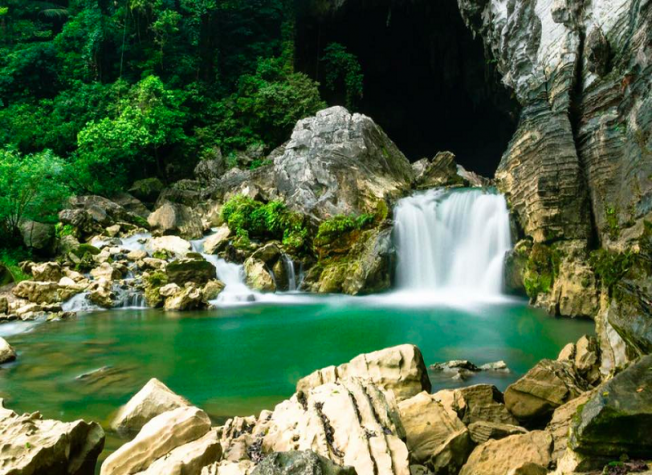
10 Best National Parks in Vietnam
Vietnam Travel Guide: If you look for the Best Wildlife Discovery Experience in Vietnam, here are...
Read More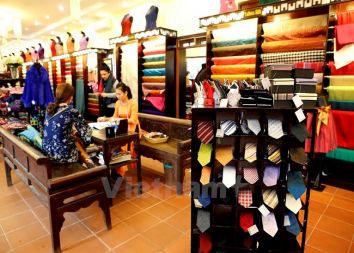
Best Souvenir to Buy in Vietnam
If you look for Best Things to Buy when traveling to Vietnam to bring home for your family & friends...
Read More
The 10 Best Places to Visit in Vietnam
Vietnam Travel Guide: Home to an extensive collection of historical and cultural attractions,...
Read More
Top 10 Museums You Should Not Miss in Vietnam
Vietnam, 4.000 years old country has a unique and lengthy history, culture with 54 ethnic groups. It...
Read MoreFind your trip
Vietnam Best Tours
Vietnam Car Rental
Vietnam Travel Blog
- Vietnamese People: Origin, History, Culture and Traditions
- Vietnam Currency: Best ATM and Places to Exchange Money
- Vietnam Map: Regions, Cities & Provinces Map of Vietnam
- What is illegal Things in Vietnam: Rules & Laws for Tourists
- Best Time to Travel to Vietnam to Avoid the Bad Weather
- Vietnam News: Population & Religions of 54 Ethnic Groups









